Do Hindus worship idols (Deity) (stone) (statue) (full and correct meaning) | Why do Hindus worship Murti? | When idol worship started in Hinduism | Is idol worship prohibited in Vedas | Who started idol worship in Hinduism?
Namaste friends, how are you doing today? Welcome to #BhagavanBhakthi website / blog.
Bhagavan Lord Sri Krishna (Vishnu) (Rama) blessings to you and your family!
In this website / blog, you will always learn about #Hinduism #Sanskrit language.
Also subscribe to my YouTube channel from this link #BhagavanBhakthi to view videos about #Hinduism #Sanskrit language.
Just before going to “Do Hindus worship idols (Deity) (stone) (statue) (full and correct meaning) | Why do Hindus worship Murti? | When idol worship started in Hinduism | Is idol worship prohibited in Vedas | Who started idol worship in Hinduism?“, let us know a brief, basic and very important information.
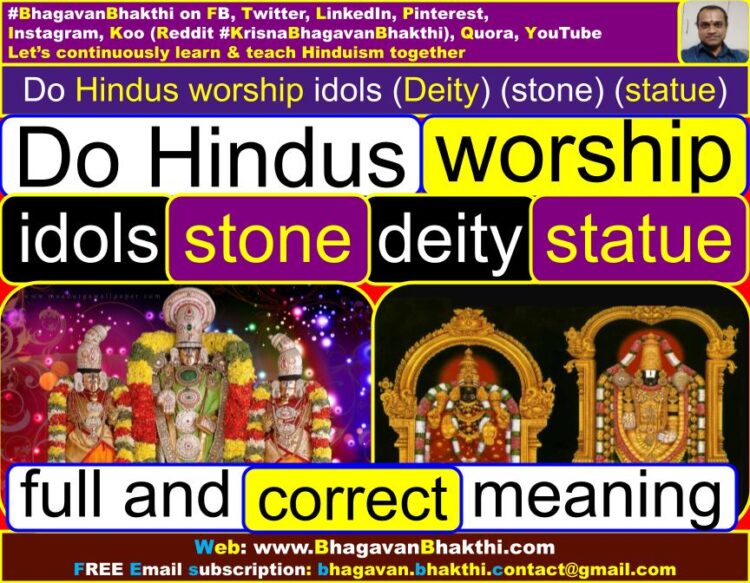
This subject is one of the most important aspect in Hinduism (Sanatana Dharma). People have been giving their own interpretations and meaning as per their own wish and will and not many people are bothered to know the correct meaning as per the Hindu Texts.
In this post or article, the meaning the idol or deity or stone or statue worship in Hinduism is given as per the Hindu Texts (Sanatana Dharma).
When idol worship started in Hinduism : Idol (deity) worship in Hinduism (India) is happening since the ‘adi kalam’ (Grand unknown period) and will continue to happen until the ‘ananta kalam’ (Grand infinite period).
In many places like Tirupati, Pandarpur, Badrikashram (Badrinath), etc. svayam (directly) Lord Sri Vishnu is standing in the form of an idol (deity) (statue).
In Tirupati, Lord Sri Vishnu is known as Lord Sri Venkateswara (Srinivasa) (Balaji). In Badrikashram (Badrinath) Lord Sri Vishnu is known as Lord Sri Badri Narayana (Nara Narayana). In Pandharpur Lord Sri Vishnu is known as Lord Sri Panduranga (Vitthal).
In each place Lord Sri Vishnu is standing in his own unique style, with unique dress, etc. He is called as ‘sarva svatantra’, this is, he is completely independent and free, and doesn’t depend on anyone or anything.
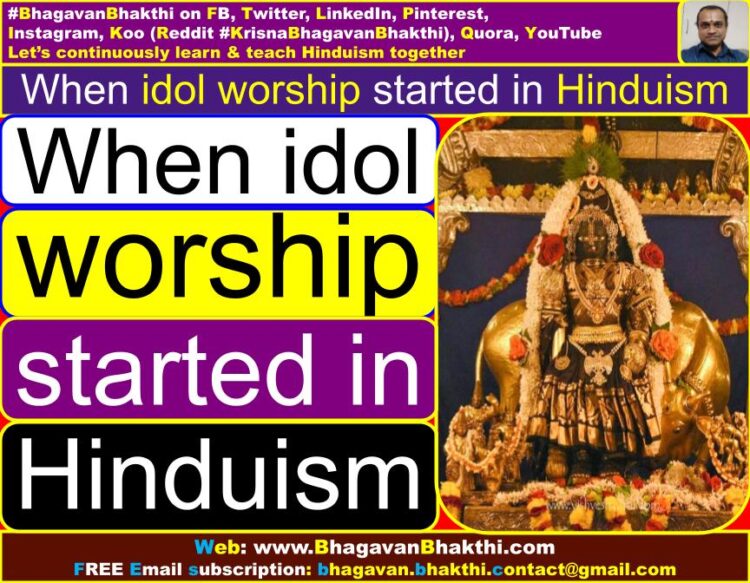
Now, let’s move to know about “Do Hindus worship Idols (Deity) (stone) (statue)” or “Why Hindus worship Idols – correct meaning”:
Let us understand this with an example.
When we salute our national flag or do namaskar to our country’s flag, does it means we are saluting or doing namaskar to a piece of cloth.
Can now we be called as cloth saluters or cloth namaskar doers? No right.
We are saluting to the national flag of our great country. That flag is representing our Great Nation India. That’s why we are saluting that flag or doing namaskar to that flag.
Similarly, when we do pooja to the statue (idol) (deity) (stone) of Lord (Bhagavan) (God) or Devatas (Demigods) means we are doing pooja of Lord (Bhagavan) (God) or Devatas (Demigods) who is present in that idol or deity or statue or stone.
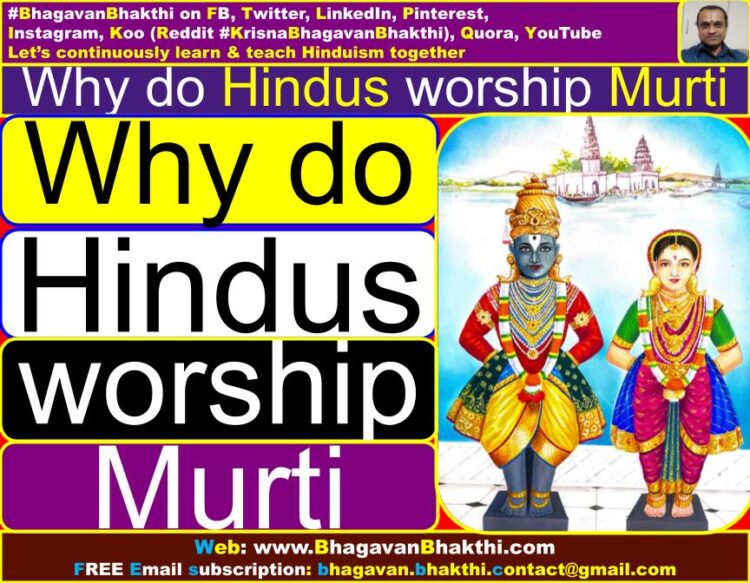
Why do Hindus worship Murti (deity) (idol) (stone) (statue) : Our Great Rishis and ancestors have seen the Bhagavan (God) and thus they know how our Bhagavan (God) looks and thus they have carved the stone into statue which they have seen earlier in Bhagavan’s (God’s) different avatars.
Bhagavan (God) gives darshan (divine view) to people in different avatars.
For example, just like Arjuna saw the great ‘Vishva roopa’ (universal form) of Lord Sri Vishnu (Krishna), whereas Kamsa saw the form which made him to be afraid.
Hanuman saw Lord (Bhagavan) (God) in Lord Sri Rama’s avatar, while Bhima saw the avatar of Lord Sri Krishna.
It is our inner atma (soul) which sees the Bhagavan (God) through our eyes.
Bhagavan (God) is called as ‘antaryami’, this means, who is present inside us from our head to toe, that is, who is present inside everything and anything including an idol or deity or stone or statue.
We need to celebrate when we see Bhagavan (God) in the form of a Murti or idol or deity or stone or statue.
Thus we need to open the eyes which is inside us to see the Bhagavan (God) inside the idol or deity or stone or statue.
In future if anyone asks you why Hindus do pooja of an idol or deity or stone or statue, you can give this example with explanation. Let’s all of us be proud of our Great Sanatana Dharma (Hinduism).

Who started idol worship in Hinduism : Lord Sri Vishnu (Rama) (Krishna) (Hari) himself started the Hinduism (Sanatana Dharma). Hinduism (Sanatana Dharma) is not started by any ordinary human.
Since how many years Hinduism is existing : It is existing since ‘aadi kalam’, means since ‘unknown age’ and will be there until ‘ananta kalam’, means ‘grand infinite’ years.
Let us all spread the Greatness of our Great Sanatana Dharma.
Now let us go little deeply : In Hinduism (Sanatana Dharma) why do we do the pooja / worship of an idol or deity or statue or stone?
Many people have this question, that is, whether Tirupati, Pandharpur, Badrinath, Udupi etc. idol or deity or statues or stones are Bhagavan (God) or not?
First of all, we need to understand that Bhagavan (God) is called “apraakruta”, means, Bhagavan (God) never took birth or would never have the end (death). Also this means, Bhagavan (God) is not naturally made like ordinary humans or doesn’t depend on nature.
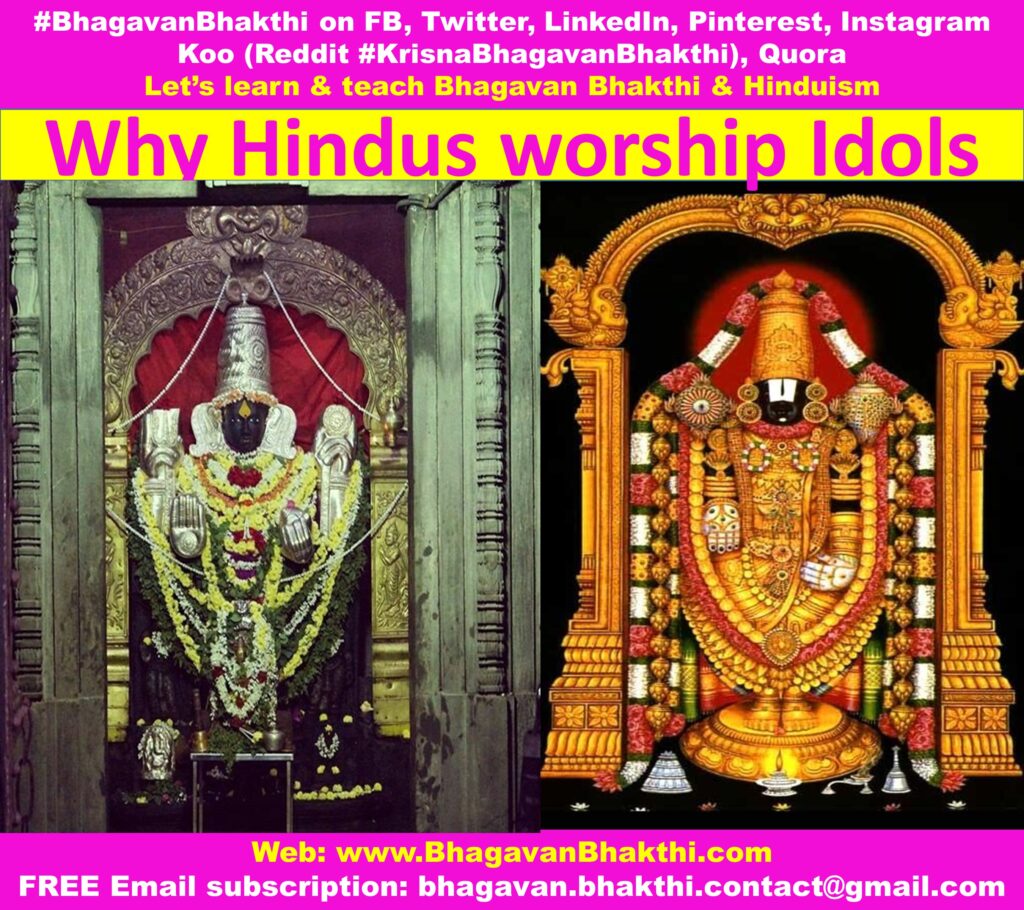
Here “apraakruta” means which is not natural (unnatural) or doesn’t dependent on nature. Bhagavan (God) is not made by natural things.
Bhagavan (God) is called “apraakruta” as he doesn’t have birth or end (death) and also means, he doesn’t comes from the natural ingredient(s) or from the nature.
Also, we should note that the idols or deities or stones or statues present in these place like Tirupati, Pandharpur, Badrinath, Udupi etc. are idols or deities or stones or statues and not direct Bhagavan (God).
The Great and Most Beautiful statue of the Bhagavan (God) which is standing in the form of Srinivasa / Venkateswara in Tirupati, or the Great and Most Beautiful statue of the Bhagavan (God) which is standing in the form of Vitthal / Panduranga in Pandharpur,
or the Great and Most Beautiful statue at the Badri Srimann Narayana (Badrinath), or the Great and Most Beautiful statue at the Udupi Sri Krishna is not Bhagavan (God), but it is an idol or deity or stone or statue.
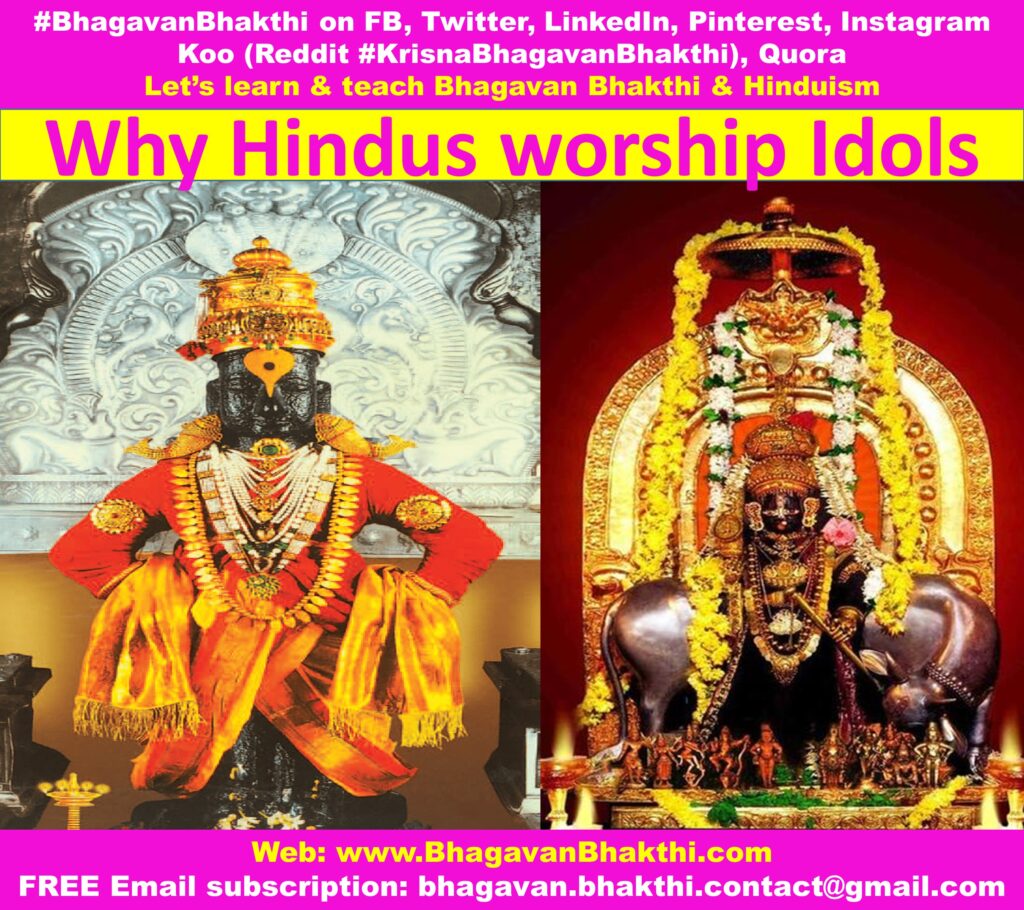
But, someone who is present inside these idols or deities or stones or statues of Tirupati, Pandharpur, Badrinath, Udupi etc. is the antaryami, means, the antaryami (present inside) which is present in these idols or deities or stones or statues is the real Bhagavan (God).
Bhagavan (God) is there inside these idols or deities or stones or statues as the “sannihita”, means someone who is present inside these idols or deities or stones or statues.
Again this means, these statues have the “sannidhaana” (divine presence) of the Bhagavan (God) in these idols or deities or stones or statues, but also we should remember these idols or deities are not directly Bhagavan (God).
The idol or deity shows the pratima of Lord Sri Vishnu (Lord Sri Krishna) (Lord Sri Rama) (Lord Sri Hari), means the svaroopa / structure / form of svayam (directly) Lord Sri Vishnu.
[Note : Some people thing pratima means stone, it is not stone, but in fact is the mirror image of svayam (directly) Lord Sri Vishnu.]
The idol or deity or stone or statue is the mirror image of Lord Sri Vishnu (Lord Sri Krishna) (Lord Sri Rama) (Lord Sri Hari).
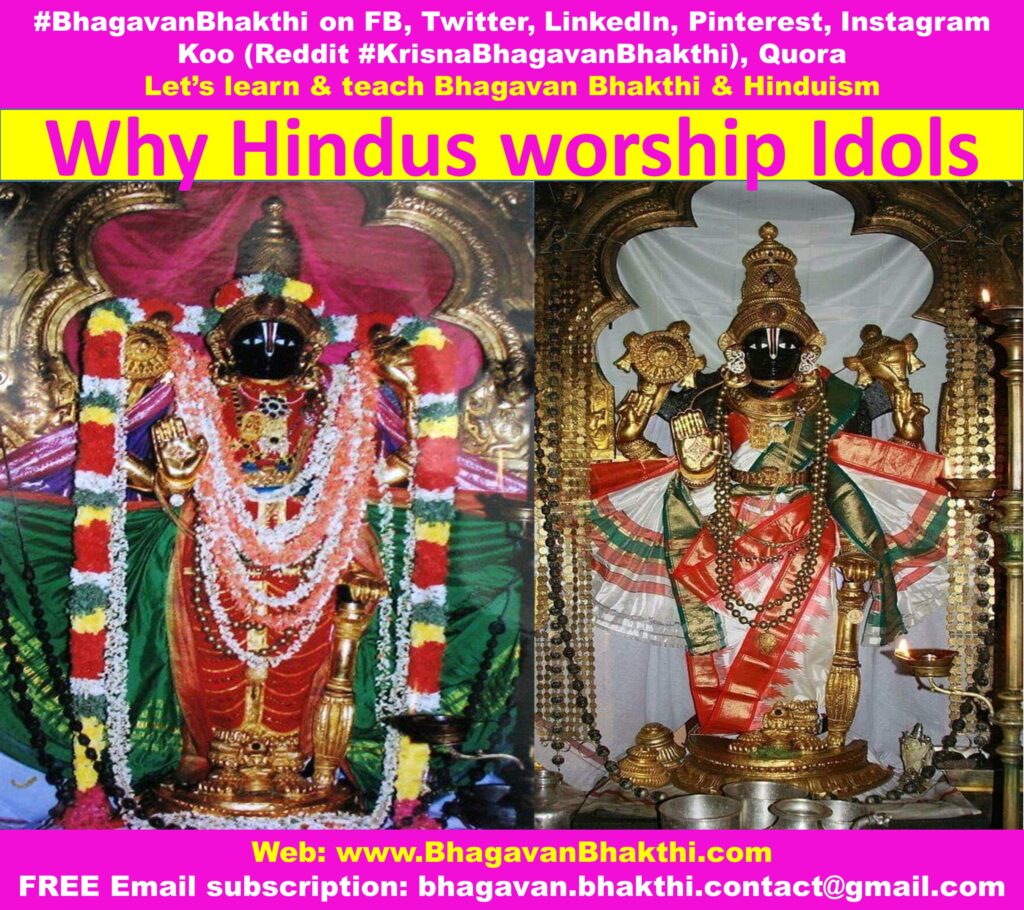
The body of the Bhagavan (God) is “chidaananda”, that is, which is full of “gnana” / gyan / knowledge, he is the one who is full of “aananda” / happiness / divine blissfulness. This means, Bhagavan (God) is not born or been given birth.
Bhagavan (God) is completely independent (free) of the nature, that is, Bhagavan (God) (Ishwar) is not dependent on nature or somebody or something else. Rather the nature is completely dependent on the Bhagavan (God) (Ishwar).
Bhagavan (God) (Ishwar) body cannot be destroyed or Bhagavan (God) (Ishwar) body doesn’t get destroyed by itself or by from external force or any force for the matter.
But, whereas the statues at the Tirupati, Pandharpur, Badrinath, Udupi etc. are made by natural ingredients, means, these idols or deities or stones or statues have been built by the natural raw materials, which can be destroyed by natural force or by some external force.
Why Hindu God is present in the form of deity or idol : Bhagavan (God) is called “karunaadheesha” (King of kindness), he is called “karunaa saagara” (Ocean of kindness) and “karunaa shaali” (Full of kindness), and thus since he has to do bless the common people and others like us,
he has to show his karuna (kindness) towards us, he has to do anugraha (bless) on us and thus he should be present on this earth in some or the other medium / form.
For this reason he is present in the form of deities or idols or stones or statues in many places all over the India and world.
This means, through these idols or deities or stones or statues, Bhagavan (God) is visible to us and does the anugraha (bless) on people like us.

Again we need to understand that Bhagavan (God) is present inside the idols or deities or stones or statues, but the idols or deities or stones or statues itself is not the Bhagavan (God) (Ishwar).
Lord (Sage) Sri Vedavyasa (He is also the avatar of Lord Sri Vishnu) has said that: “na pratike, nahi saha”.
This means, in pratika or idol or deity or stone or statue, Bhagavan (God) (Ishwar) is present, but the idols or deity or stone or statue itself is not Bhagavan (God).
Not only the idols or deities present at the Tirupati, Pandharpur, Badrinath, Udupi etc., but also the idols or deities which are present in other temples around the world, our houses, in the form of saligrama, etc. all are idols or deities or stones or statues, but not Bhagavan (God) by itself.
But, Bhagavan / God / Ishvar / Parabrahma / Lord Sri Krishna / Lord Sri Vishnu / Lord Sri Hari etc. is present inside these idols or deities or stones or statues as “antaryaami” (divine present inside).
Also, we should note that the antaryami Bhagavan (God) present in Great places like Tirupati, Pandharpur, Badrinath, Udupi etc. are different and the idols or deities or stones or statues which are present in other temples or in our houses are different.
The statues present in these places like Tirupati, Pandharpur, Badrinath, Udupi etc. are either installed by Great people (Devatas / Demigods) of the Bharatiya Sanatana Dharma or svayam Bhagavan (God) has been sitting in these places in the form of statues as “udhbhava moorti” (self manifested).
This is similar to other Devatas / Demigods also. Other Devatas / Demigods like svayam (directly) Goddess Sri Mahalakshmi Devi, Lord Sri Brahma Deva,
Lord Sri Mukhya Praana Deva (next Lord Sri Brahma Deva), Goddess Sri Sarasvati Devi, Goddess Sri Bharati Devi (next Sri Sarasvati Devi), Lord Sri Rudra Deva (Shiva), Goddess Sri Parvati Devi,
Lord Sri Ganesha, Lord Sri Kartikeya or any Devatas / Demigods may be, we need to think that the Bhagavan (God) or Devatas / Demigods are present in the idols or deities and idols or deities by itself are not Bhagavan (Gods) or Devatas / Demigods.
But, they are present inside these idols or deities or stones or statues as either svayam (directly) Bhagavan (God) or Devatas / Demigods.

Also, we need to remember that the body of Bhagavan (God) is “apraakruta” means which is not natural (unnatural).
But whereas the bodies of Lord Sri Brahma Deva, Lord Sri Mukhya Praana Deva (next Lord Sri Brahma Deva),
Goddess Sri Sarasvati Devi, Goddess Sri Bharati Devi (next Goddess Sri Sarasvati Devi), Lord Sri Rudra Deva (Shiva), Goddess Sri Parvati Devi, Lord Sri Ganesha, Lord Sri Kartikeya or any Devatas / Demigods are completely “praakruta” (natural).
This again means, all these Devatas / Demigods are completely dependent on Bhagavan (God) and these Devatas / Demigods are not independent.
All these Devatas / Demigods only follow the instructions of Bhagavan (God), that is, Lord Sri Vishnu or Lord Sri Krishna or Lord Sri Rama or Lord Sri Hari.
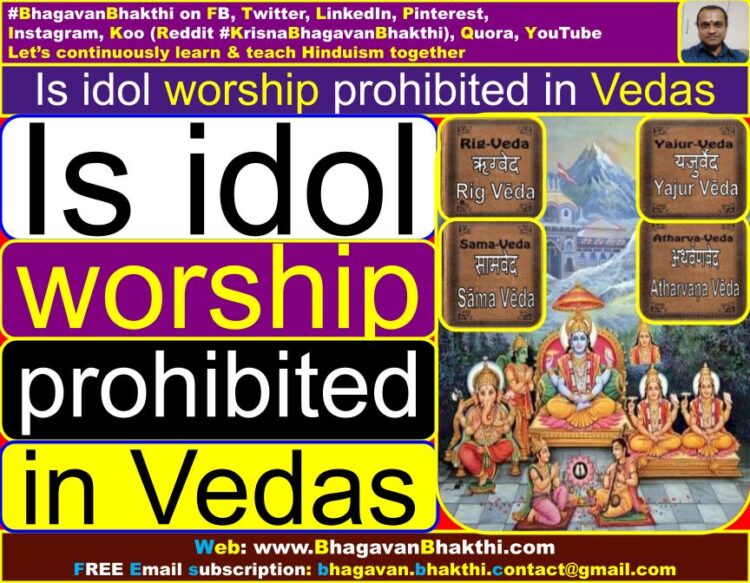
Is idol worship prohibited in Vedas : As per Vedas we shouldn’t be worshipping all the idols or deities or stones or statues which are installed by ordinary humans.
But, we need to worship only those idols or deities or stones or statues which are either installed by Lord Sri Vishnu himself or his great devotees like Pandavas, Prahlada, ancient Rishis, ancient Kings, etc.
Similarly, we shouldn’t be worshipping only the idol or deity or stone or statue, but we need to worship the Bhagavan (God) (Ishwar) present inside (antaryami) that idol or deity or stone or statue.
Final words : The idols or deities or stones or statues are not Bhagavan (God) (Ishwar), but rather the Bhagavan (God) (Ishwar) who is present as the antaryami, that is, divinely present inside the idols or deities or stones or statues is the real “Bhagavan (God) (Ishwar)”.
This means, Bhagavan (God) (Ishwar) is present inside the statue as antaryami and idols or deities or stones of statues by itself is not Bhagavan (God) (Ishwar).
This is similar to the other Devatas / Demigods also.
Continue reading about Hinduism (Sanatana Dharma) : Hinduism (Sanatana Dharma) information, facts, etc.
More information will be added to his post (article) on regular basis. Please visit again to know the updated information after some time.
To watch videos on #Hinduism #Sanskrit language, SUBSCRIBE to my YouTube channel from this below link:
#BhagavanBhakthi YouTube channel
To know more about “Lord Sri Vishnu stories, information, facts, significances, etc.“, please click the below link:
Lord Sri Vishnu stories, information, facts, significances, etc.
Dear friends, if you need any clarifications about this post, kindly let me know, I will definitely try to answer all of them.
Also your one LIKE, one COMMENT, One Share, one SUBSCRIPTION is highly important.
This will help to know the quality of this content and also it will be helpful to know if any improvements is required for the content.
If you feel this content is useful to you and has helped you to improve your knowledge, kindly share this with your well-wishers.
Because “SHARING MEANS CARING”.
For receive FREE EMAIL SUBSCRIPTION about #BhagavanBhakthi, you can send an email to [email protected] from your email ID.
NAMASTE!
SRI GURUBHYO NAMAHA
OM NAMO NARAYANAYA
Sri Krishnaarpanamastu
Share in Social Media